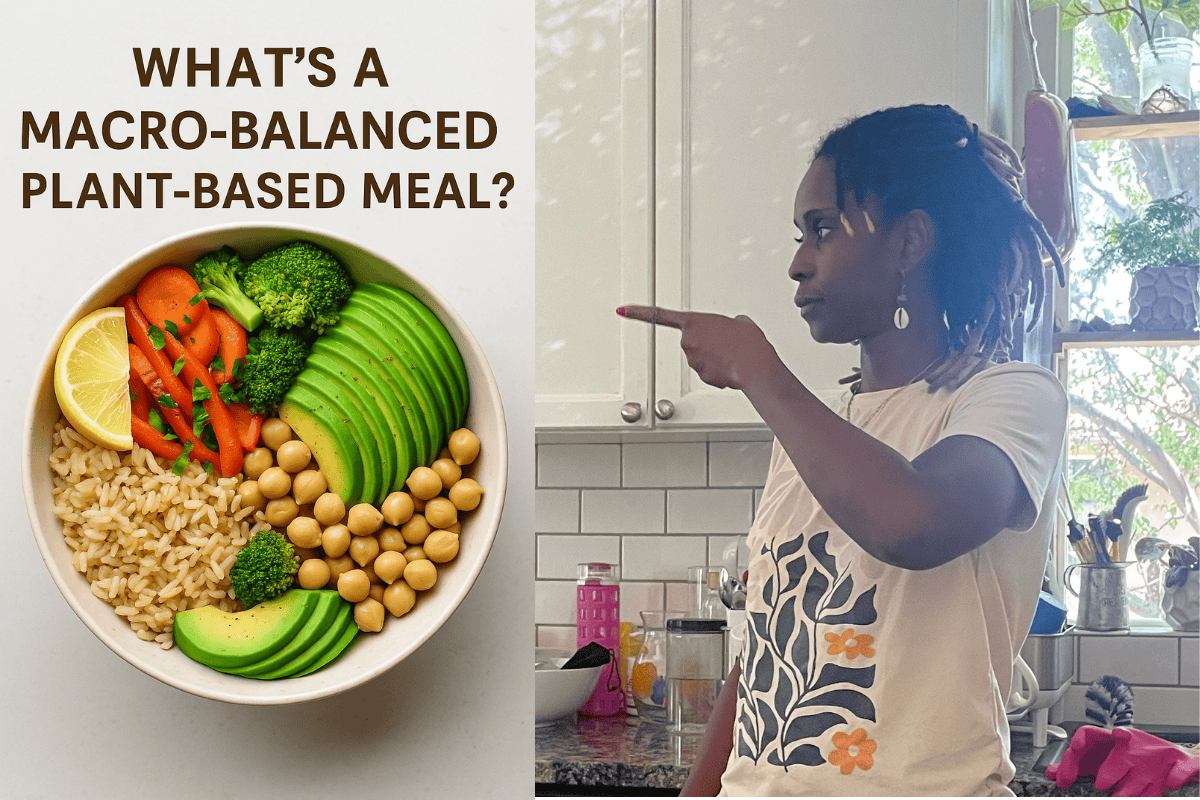
What This Post Is About
If you’ve ever heard wellness coaches toss around the term “macro-balanced” but feel unsure what it actually looks like on your plate, this post is for you. I’ll break down what macros are, why they matter for plant-based living, and how to build a macro-balanced plant-based meal that leaves you feeling satisfied, energized, and strong.
1. What Are Macros, Anyway?
Macros is short for macronutrients: the three big nutrients your body needs in larger amounts to function:
- Carbohydrates: your primary energy source
- Proteins: to build and repair tissues, including muscle
- Fat: for hormone health, energy storage, and brain function
Think of macros as the building blocks of every meal. Getting the right balance of them supports everything from your mood to your metabolism.
In a plant-based diet, macro balance is key because specific nutrients, such as protein, require a little extra planning to obtain enough of.
2. Why Macro Balance Matters on a Plant-Based Diet
One myth I hear over and over is that “plant-based equals healthy by default.” But the truth is, you could technically eat nothing but French fries and still call yourself plant-based!
That’s where a macro-balanced approach comes in:
✅ It prevents energy crashes
✅ Supports muscle and fitness goals
✅ Keeps you feeling full
✅ Helps manage cravings
✅ Avoids accidental nutrient gaps
For busy women especially, building a macro-balanced plate can mean fewer afternoon crashes, more stable moods, and steadier energy to handle everything on your to-do list.

3. The 3 Macros in a Plant-Based Meal
Let’s get practical. Here’s what you want on your plate:
a.🌾 Carbohydrates
Whole, fiber-rich carbs should form the foundation of a macro-balanced plant-based meal. Think:
- Sweet potatoes
- Quinoa
- Brown rice
- Beans and lentils
- Oats
These complex carbs digest more slowly, giving you sustained energy rather than a sugar high and crash.
b.🌱 Protein
Yes, plant-based protein is absolutely doable! Aim for sources like:
- Lentils and beans (about 15g protein per cooked cup)
- Tofu and tempeh (about 20g protein per cooked cup for the tofu, 30g for the tempeh)
- Edamame (about 17g protein per cooked cup)
- Hemp, chia, and flax seeds (about 1.5-3g protein per tablespoon)
- Whole grains like farro and quinoa (about 6-8g protein per cooked cup)
Try to include some protein at every meal, not just at dinner, to keep your body fueled.
c.🥑 Healthy Fats
Don’t fear the fat! Healthy, whole-food plant fats help you absorb fat-soluble vitamins (A, D, E, and K) and keep you satisfied. Add:
- Avocado
- Nuts and seeds
- Nut butters
- Extra-virgin olive oil
If you’ve ever finished a giant salad and still felt hungry, you probably needed more healthy fats in the mix.
4. How to Build a Macro-Balanced Plant-Based Meal (Simplified)
I like to keep it super simple because, let’s be honest, we’re juggling enough already. Here’s an easy framework you can use every day:
🥣 Half your plate: colorful veggies + complex carbs
🍛 A quarter of your plate: plant-based protein
🥑 A quarter of your plate: healthy fats
Bonus: sprinkle in herbs, spices, or fermented foods (like sauerkraut) to boost flavor and gut health.
5. Macro-Balanced Meal Examples
Need real-life inspiration? Here are a few of my go-to’s:
✅ Buddha Bowl: brown rice, roasted chickpeas, steamed broccoli, avocado, tahini drizzle
✅ Lentil Tacos: corn tortillas, spiced lentils, shredded cabbage, guacamole
✅ Protein Oats: rolled oats cooked with soy milk, hemp seeds, nut butter, and berries
✅ Stuffed Sweet Potato: baked sweet potato, black beans, sautéed kale, salsa
6. You Don’t Have to Get It Perfect
If you take away one thing from this post, let it be this:
A macro-balanced plate is about gentle structure, not perfection.
If one meal is heavier on carbs or a bit lower on protein, that’s OK. Think of macro balance for your day rather than obsessing over each bite.
7. Wrap-Up: Plant-Based, Macro-Smart, and Real
Building a macro-balanced plant-based meal is a powerful, practical way to nourish your body and mind while still honoring your busy, beautiful life.
If you’re curious about diving deeper into macro-balanced plant-based living, stick around; I’m sharing more practical guides, recipes, and wellness tools every week.
✨ Want more support? Chat with my PlantPower Mama AI: your personal plant-based meal planning assistant that helps you build balanced, easy meals even on your craziest days. Try it here! ➡️ link to the GPT tool here
🌿 7 Warning Signs Your Body Is Screaming for Fresh Plant-Based Foods
💪 Crushing Emotional Eating: Strategies for Busy Moms
📖 How I Adapt Dr. Fuhrman’s Nutritarian Diet to Fit My Gut Health (And Why It Still Works)
Frequently Asked Questions
How to manage macros on a plant-based diet?
Managing your macros on a plant-based diet is all about planning variety. Include a source of complex carbohydrates (like brown rice or sweet potatoes), plant-based protein (like tofu, lentils, or beans), and healthy fats (like avocado or seeds) in each meal. Tracking apps can help, but you don’t need to get obsessed: aim for balance across the day rather than stressing over every bite.
What is a well balanced plant-based diet?
A well-balanced plant-based diet focuses on whole, minimally processed foods: fruits, vegetables, whole grains, legumes, nuts, and seeds. It includes a balance of macronutrients (carbs, protein, fats) along with essential micronutrients like B12, iron, calcium, and omega-3s. The key is variety: eating the rainbow, including plenty of fiber, and supplementing as needed (especially B12) to cover any gaps.
How to get 30g protein per meal vegan?
Hitting 30g of protein in one vegan meal is totally doable with smart choices. Try these combos:
✅ 1 cup cooked lentils (15g) + ½ block firm tofu (15g)
✅ 1 cup tempeh (30g)
✅ 1 cup cooked chickpeas (15g) + 3 tablespoons hemp seeds (10g) + 2 tablespoons nut butter (5g)
Mixing multiple plant proteins helps you reach that 30g target while still enjoying variety and flavor.
What is 40 40 20 macros vegetarian?
The “40 40 20” macro split means:
– 40% of your calories from carbs
– 40% from protein
– 20% from fats
It’s a popular macro ratio for building lean muscle and supporting weight loss. For vegetarians or vegans, this means focusing on higher-protein plant foods like lentils, tofu, tempeh, protein-rich grains like quinoa, plus healthy fats from nuts, seeds, and avocados.




